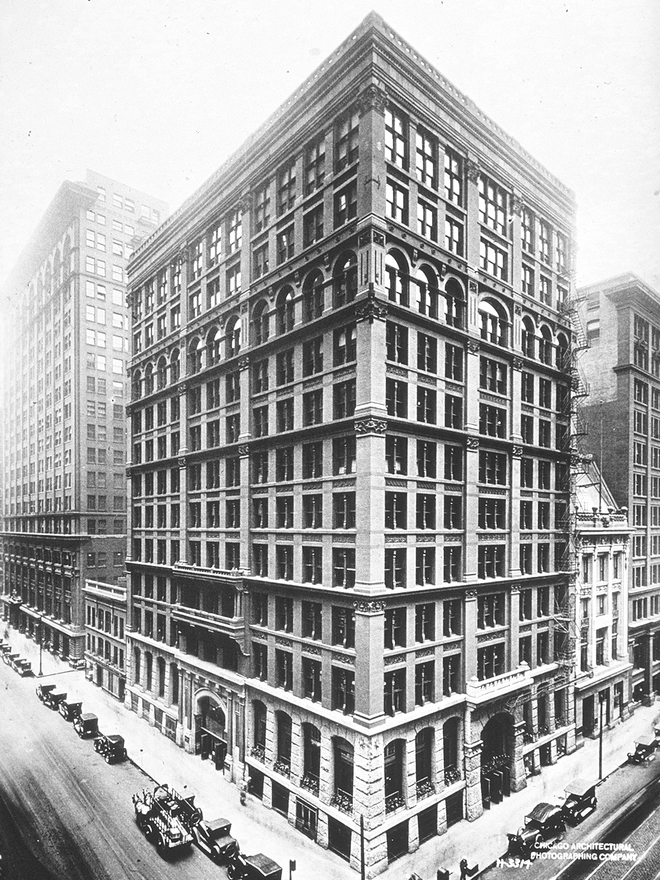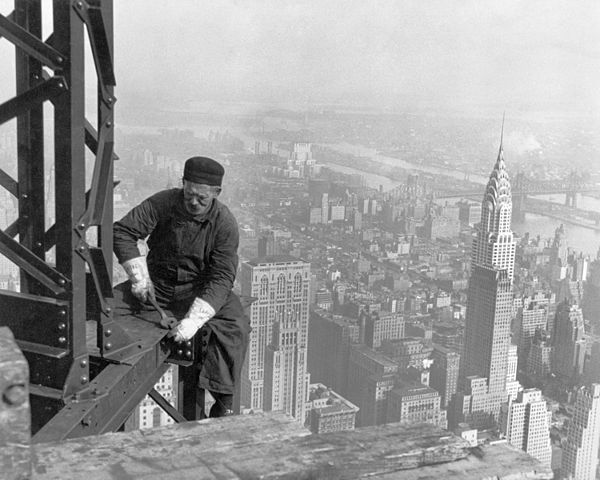Skyscrapers are the world’s tallest buildings. They first appeared in New York and Chicago at the end of the 19th century. Skyscrapers are often like small cities. They offer space for offices, apartments, shops, hotels, restaurants and other services. Tens of thousands of people live and work there.

The Home Insurance Building in Chicago is thought to be the first skyscraper – built in 1885
Image:Chicago Architectural Photographing Company, Public domain,
via Wikimedia Commons
Building Skyscrapers
Skyscrapers have two parts: the foundation is the part below the ground and the superstructure is the part above the ground. Both sections hold the weight of the building.
A skyscraper needs careful planning before it can be built. First a big hole a few stories deep is dug into the earth. Sometimes this foundation reaches into solid rock. Then steel and concrete beams and columns are placed into it. They carry the weight of the superstructure.
When the foundation is finished cranes are used to raise a steel frame up into the sky. The pieces of this frame are bolted together. As it moves upward other workers lay floors and hang in the outside walls. The complete structure of the skyscraper must be finished before the inside systems can be installed.
A skyscraper must also be able to hold off strong winds. Modern buildings are able to swing a few metres in each direction, like a tree, without damaging the structure. Sometimes a steel core rises upwards from the inside of the building to give it better support.

Workman on the frame of the Empire State Building
Image: Taken by Lewis Hine, edited by Durova,
Public domain, via Wikimedia Commons
Service Areas
Corridors , staircases, elevators, heating systems, air conditioning and electrical systems belong to the most important inner elements of a skyscraper. Although the outside structure can be completed in a few weeks it may take years to finish the whole building.
Pumps bring clean water to all parts of the skyscraper, the drainage system carries away water and waste materials.
Air conditioning and heating systems control the temperature in the building the whole year round. Electrical systems provide power and communication throughout the building and wires carry electricity to each floor. Elevators are the most important systems of a skyscraper. They carry people up and down at speeds of up to 500 metres per minute.
History of Skyscrapers
Two discoveries in the middle of the 1800s made it possible to build modern skyscrapers. Before the Industrial Revolution brick and stone walls carried the weight of buildings. Because each floor was very heavy it was impossible to build very high houses. In the middle of the 19th century steel became an important building material. This metal was strong and light. Architects could now construct a steel skeleton to support very tall buildings. Chicago’s Home Insurance Company Building was ten stories tall and the first skyscraper to use such a steel construction.
Skyscrapers would have been useless if people had to walk up and down many flights of stairs. In 1853 an elevator safe enough to carry passengers was invented by Elisha Graves Otis.
During the early 20th century the construction of tall buildings became very popular in big cities. Cities grew bigger as more and more people could live and work there. Tall buildings were also seen as a symbol of power and greatness. Thus, major cities, especially in America, fought for the tallest buildings in the world. For four decades the Empire State Building in New York was the world’s highest structure. The 381 metre high landmark has 102 stories and was completed in 1932. The World Trade Centre, finished in 1973, became a symbol the city’s economic strength. Even though many New Yorkers did not like them at the beginning, they got used to the “Twin Towers” in the middle of Manhattan. The destruction of the World Trade Centre in the terrorist attacks of 2001 hit the heart of the city.
Today the world’s tallest buildings no longer stand in America. Other countries, mainly in the growing regions of Asia, have entered the prestigious race for the tallest structures in the world. The 452 metre high Petronas Towers in Malaysia, completed in 1996, became the first skyscraper outside the US to climb the top of the list. The Burj Khalifa, completed in 2010, is currently the world’s highest building. It has a height of 828 metres spanning 163 floors.
As the race for the world’s tallest building continues most experts have different opinions on how tall skyscrapers can become. Some say building a 1000-metre high structure would be no problem with today’s technology; others think that we would need lighter, stronger materials as well as faster elevators to make this possible
.
The World’s Tallest Buildings
Image: Phoenix CZE, CC BY-SA 4.0,
via Wikimedia Commons
Burj Khalifa
Burj Khalifa in Dubai is the world’s tallest building. The structure reaches a height of over 800 metres. It was designed by an American company and built at a cost of over 1.5 billion dollars. Over 12,000 men and women worked on the building during the peak of construction.
The skyscraper does not have a steel frame but a concrete structure. Thousands of glass panels give it a futuristic appearance.
Burj Khalifa is a multi-use building. It contains apartments, hotels, restaurants and sky lobbies.